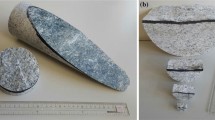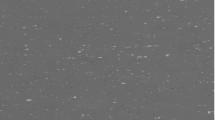Summary
A tensile fracture of about 1 m in length was created by indenting wedges in a block of granite, and the heights of the two fracture surfaces were measured using a large, non-contact surface profile measurement system with a laser profilometer to determine the aperture distribution of the fracture. Based on the measured data, the frequency characteristics of the asperity heights, the initial aperture (the aperture when the surfaces are in contact at a single point), and the size effect on the statistical properties were analyzed. The results can be summarized as follows:
-
1.
The relation between the power spectral density of the fracture surface and the spatial frequency shows linearity on a log–log plot and thus the fracture surfaces can be assumed to be fractal object. On the other hand, the power spectral of the initial aperture becomes almost constant for wavelengths greater than about 100 mm. Thus, the matedness between the two surfaces of a fracture of 1 m monotonously increases with wavelength.
-
2.
The standard deviation of the initial aperture increases with fracture size until the fracture size is about 200 mm, beyond which the standard deviation is almost independent of the fracture size. On the other hand, the mean initial aperture still increases when the fracture size exceeds 200 mm, since the initial aperture depends on the minimum value of the aperture, which decreases with the number of data points.
Similar content being viewed by others
References
B. K. Atkinson (1987) Fracture mechanics of rock Academic Press London
S. R. Brown (1987) ArticleTitleFluid flow through rock joints: The effect of surface roughness J. Geophys. Res. 92 1337–1347 Occurrence Handle10.1029/JB092iB02p01337
S. R. Brown (1989) ArticleTitleTransport of fluid and electric current through a single fracture J. Geophys. Res. 100 5841–5952
S. R. Brown (1995) ArticleTitleSimple mathematical model of a rough fracture J. Geophys. Res. 100 5941–5952 Occurrence Handle10.1029/94JB03262
S. R. Brown C. H. Scholz (1985) ArticleTitleBroad bandwidth study of the topography of natural rock surfaces J. Geophys. Res. 90 12575–12582 Occurrence Handle10.1029/JC090iC06p11667
N. Fardin O. Stephansson L. Jing (2001) ArticleTitleThe scale dependence of rock joint surface roughness Int. J. Rock Mech. Min. Sci. 38 659–669 Occurrence Handle10.1016/S1365-1609(01)00028-4
Fardin, N., Stephansson, O., Jing, L. (2003): Scale effect on the geometrical and mechanical properties of rock joints. Proc., 10th Congress of the ISRM, Sandton, South Africa, vol. 1, 319–324.
N. Fardin Q. Feng O. Stephansson (2004) ArticleTitleApplication of new in situ 3D laser scanner to study the scale effect on the rock joint surface roughness Int. J. Rock Mech. Min. Sci. 41 329–335
Q. Feng N. Fardin L. Jing O. Stephansson (2003) ArticleTitleA new method for in-situ non-contact roughness measurement of large rock fracture surfaces Rock Mech. Rock Engng. 36 IssueID1 3–25 Occurrence Handle10.1007/s00603-002-0033-1
G. Grasselli J. Wirth P. Egger (2002) ArticleTitleQuantitative three-dimensional description of a rough surface and parameter evolution with shearing Int. J. Rock Mech. Min. Sci. 39 789–800 Occurrence Handle10.1016/S1365-1609(02)00070-9
P. W. J. Glover K. Matsuki R. Hikima K. Hayashi (1998) ArticleTitleSynthetic rough fractures in rocks J. Geophys. Res. 103 9609–9620 Occurrence Handle10.1029/97JB02836
F. Lanaro (2000) ArticleTitleA random field model for surface roughness and aperture of rock fractures Int. J. Rock Mech. Min. Sci. 37 1195–1210 Occurrence Handle10.1016/S1365-1609(00)00052-6
F. Lanaro O. Stephansson (2003) ArticleTitleA unified for characterisation and mechanical behaviour of rock fractures Pure Appl. Geophys. 160 989–998 Occurrence Handle10.1007/PL00012577
Lanaro, F., Jing, L., Stephansson, O. (1998): 3D-laser laser measurements and representation of roughness of rock fracture. In: Proc., Mechanics of Jointed and Faulted Rock, Vienna, A. A. Balkema, Rotterdam, 185–189.
G. M. Lomize (1951) Water flow through jointed rock Gosenergoizdat Moscow 127
A. Marache J. Riss S. Gentier J.-P. Chiles (2002) ArticleTitleCharacterization and reconstruction of a rock fracture surface by geostatistics Int. J. Numer. Anal. Meth. Geomch. 26 873–896 Occurrence Handle10.1002/nag.228
K. Matsuki T. Kojima T. Murai (1995) ArticleTitleSurface roughness and initial aperture of a small-scale hydraulic fracture in a granite J. Geotherm. Res. Soc. Jpn. 17 213–232
K. Matsuki J. J. Lee K. Sakaguchi (1999) ArticleTitleSize effect in flow conductance of a closed small-scale hydraulic fracture in granite Geotherm. Sci. Technol. 6 113–138
K. Matsuki N. Fukuoka J. Tomono K. Sakaguchi (2001) ArticleTitleSize effect on fracture permeability estimated by using synthetic fractal fracture J. Geotherm. Res. Soc. Jpn. 23 127–139
Y. Meheust J. Schmittbuhl (2003) ArticleTitleScale effects related to flow in rough fractures Pure Appl. Geophys. 160 1023–1050 Occurrence Handle10.1007/PL00012559
K. Sakaguchi T. Noshiro K. Matsuki K. Okumura (1999) ArticleTitleEffects of grain size on geometrical characteristics of hydraulic fractures J. Geotherm. Res. Soc. Jpn. 21 1–12
Takahashi, H., Abe, H. (1981): Design methodology of artificial crack-like reservoirs for HDR geothermal energy extraction – an overview of the Γ-Project in Japan. In: Proc., Geothermal Energy Symposium, ASME, 25–32.
M. E. Thompson S. R. Brown (1991) ArticleTitleThe effect of anisotropic surface roughness on flow and transport in fracture J. Geophys. Res. 96 21923–21932 Occurrence Handle10.1029/91JB02252
Wang, E. Q., Sakaguchi, K., Okumura, K., Matsuki, K. (2000): Time-dependent closure and permeability of a small-scale hydraulic fracture under constant normal stress. In: Proc., World Geothermal Congress, 3951–3956.
I. W. Yeo M. H. De Freitas R. W. Zimmerman (1998) ArticleTitleEffect of shear displacement on the aperture and permeability of a rock fracture Int. J. Rock Mech. Min. Sci. 35 IssueID8 1051–1070 Occurrence Handle10.1016/S0148-9062(98)00165-X
Author information
Authors and Affiliations
Additional information
Authors’ address: Dr. Kiyotoshi Sakaguchi, Graduate School of Environmental Studies, Tohoku University, 6-6-20 Aramaki-Aza-Aoba, Aoba-ku, Sendai 980-8579, Japan
Rights and permissions
About this article
Cite this article
Sakaguchi, K., Tomono, J., Okumura, K. et al. Asperity Height and Aperture of an Artificial Tensile Fracture of Metric Size. Rock Mech Rock Eng 41, 325–341 (2008). https://doi.org/10.1007/s00603-005-0102-3
Received:
Accepted:
Published:
Issue Date:
DOI: https://doi.org/10.1007/s00603-005-0102-3




